Linkfest #12: Tyromancy, "Point Nemo", and Why Movie Villains Never Use Iphones
Welcome to the latest edition of the Linkfest! I call it "the opposite of doomscrolling".
Thank you for being a subscriber; if you’re enjoying it, spread the word – it’s a pay-what-you can signup here; the folks who can afford to contribute help keep it free for everyone else, too. Please forward this newsletter to anyone you think might like it.
Let's get to it! Here's the best stuff I've found online recently ...
1) 👗 Interactive dress that changes its patterns on the fly
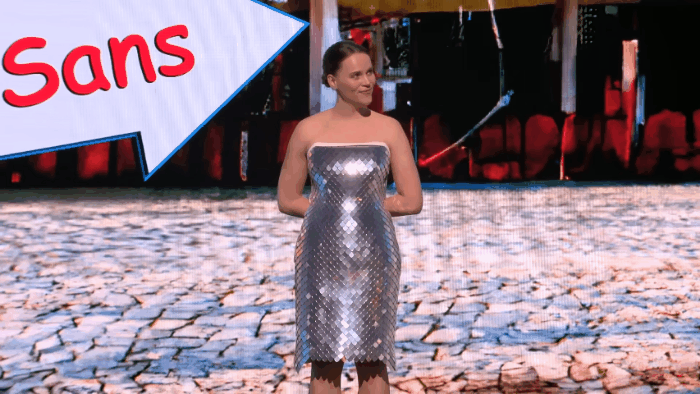
Christine Dierk is a research scientist at Adobe who headed up a team to create a truly wild dress (YouTube link here). It's made of light-diffusing panels, of the sort often used to make "smart" windows that can change their translucency.
Dierk used that technology to create petal-shaped pixels that display shifting patterns on the dress. Watch this demo to see it in action. It's really trippy! At 2:13 she shows off a mode where the animation on the dress responds to her bodily movements.
Here's another teaser video showing handbags Dierk made using the same technique. The panels are reflective -- they don't exude light themselves -- so, rather like e-ink screens, they don't require much power; you only need a current when you change their polarity.
Dierk's clothing and bags are just demos, so, nothing that's gonna hit the market soon. But if she ever markets a coat made of this stuff I'm getting one, lol.
2) 🎨 The recluse artist who created 7,000 works in secrecy
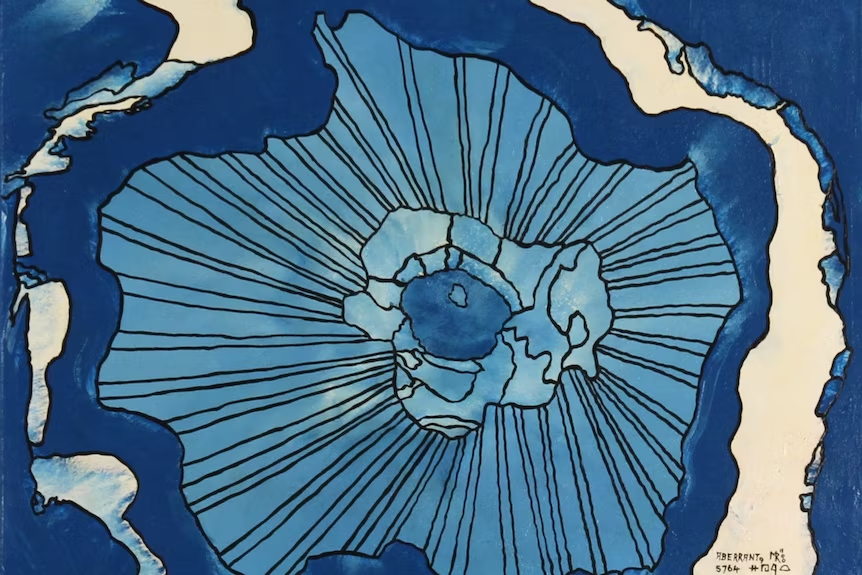
In the late 1980s, Robert Martiensen -- a retired math teacher in Australia -- started to produce an astounding amount of art. Hidden away in a farmhouse he grew up in, Martiensen began by crafting wooden boxes with swoopy, organic shapes; in four years, he made 2,500 of them. Then he started doing modernist paintings -- and did that for two decades, creating over 4,000 canvases.
The thing is, he did this in almost complete secrecy. He never showed it to anyone except his niece. When he died in 2007, his family was astounded to discover his massive oeuvre.
His family initially wanted to sell off the whole lot for cheap, but thankfully an art valuer, Elizabeth Arthur, intervened and the stuff is now on display:
When Dr Arthur arrived, the paintings had already been cleared from Martiensen's farmhouse and placed in a warehouse in Mount Gambier.
Though an experienced art valuer, she was unprepared for the scale of the collection.
"There were these hundreds, thousands of paintings all around the walls and stacked in the middle. The most amazing sight." [snip]
"An outsider artist is one who has no training, no contact with the art world at all," she said.
"To have produced many paintings, he would have been extremely disciplined. So I think he slept very little, and ate very little.
There's a story about it on ABC's web site, short but fascinating to read. Martiensen's woodworks are gorgeous ...

... and his abstracts are straight outta modernism ...
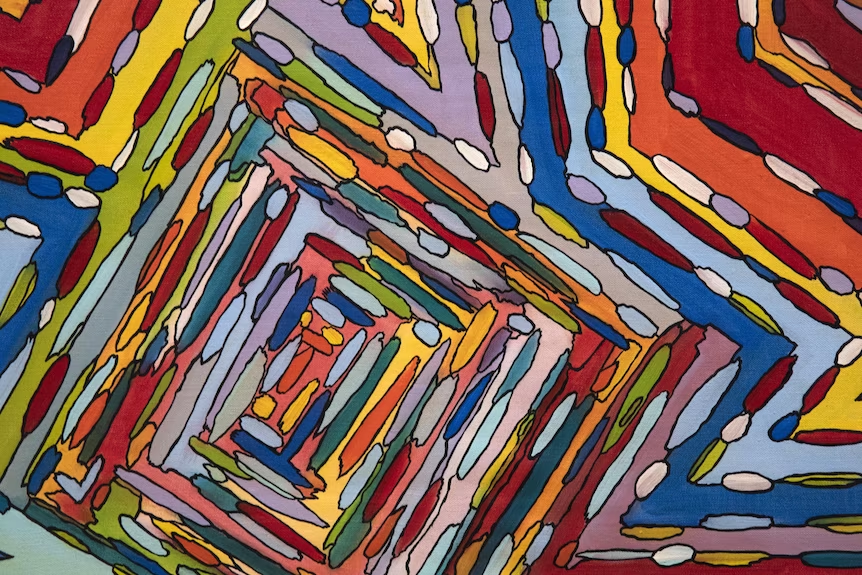
I don't know if there's a book of his work, but if I can find one I'm going to get it.
3) 🎶 A pocket-sized record player from 1924
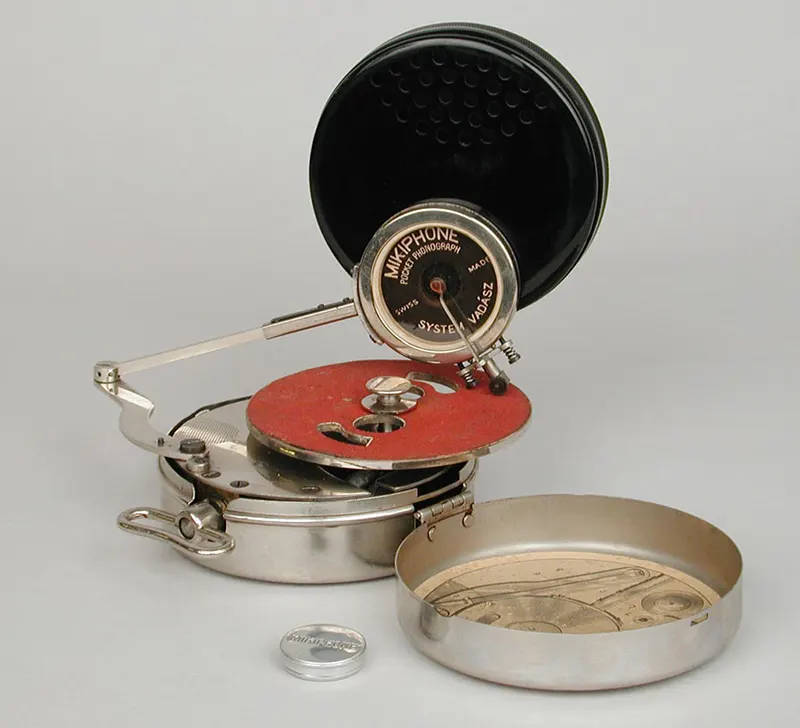
Behold the Mikiphone, a pocket-sized record player invented by two Hungarian siblings. They got a Swiss company to mass-produce it, and according to this story at Rare Historical Photos, 180,000 of them were manufactured.
When folded up, it looked like a cosmetics compact ...

... but once unfolded and assembled, it played 10-inch records!
As they write ...
The recording head and a two-piece Bakelite resonator had to be connected to the foldout tone arm before the shellac disc could be placed on the turntable’s central pin.
This precision engineering feat was awarded first prize at an international music exhibition in Geneva in 1927.
4) 🕹 36 versions of Pong
![A screenhot of Pong, except there's text on each side of the game, reading: "SELECT YOUR MOVE", and beneath that, "[W] - UP, [S] - DOWN, [A] - SKIP TURN" and "[UP] - UP, [DOWN] - DOWN, [RIGHT] - SKIP TURN"](https://assets.buttondown.email/images/f413b9ef-df0b-4f60-9a22-5b9d00b3fa58.jpg?w=960&fit=max)
"Pongs" is a fascinating project by designer Pippin Barr: 36 variants of the classic game.
In each case, Barr tweaks the rules in some witty fashion, making you see Pong in a new light. There's a version where the ball starts off huge and shrinks every time you hit it; there's "inverse" Pong where you play as the walls, and the one picture above -- "Turn-based Pong", where the game advances frame by frame, with each player picking what direction their paddle will move in, like an RPG.
Barr first released this in 2012, and wrote a fun design diary as he worked, which is here. As he concluded ...
... PONGS has come to symbolise certain “larger” issues of game design for me. In particular, making variants of something as simple as PONG helped me to distill in some way what games might be made of. Or rather than that, perhaps, it has been in playing the games and seeing how much of a difference a tiny rule change makes to the experience (and strategies and all that) of play that have been illustrative. I’m not clear that it’s helped me perceive any deeper truths about “what games are” or anything, but experientially, at least, it has felt interesting and worthwhile. Your mileage will almost certainly vary.
5) 🚀 "Point Nemo", the Pacific graveyard of space debris
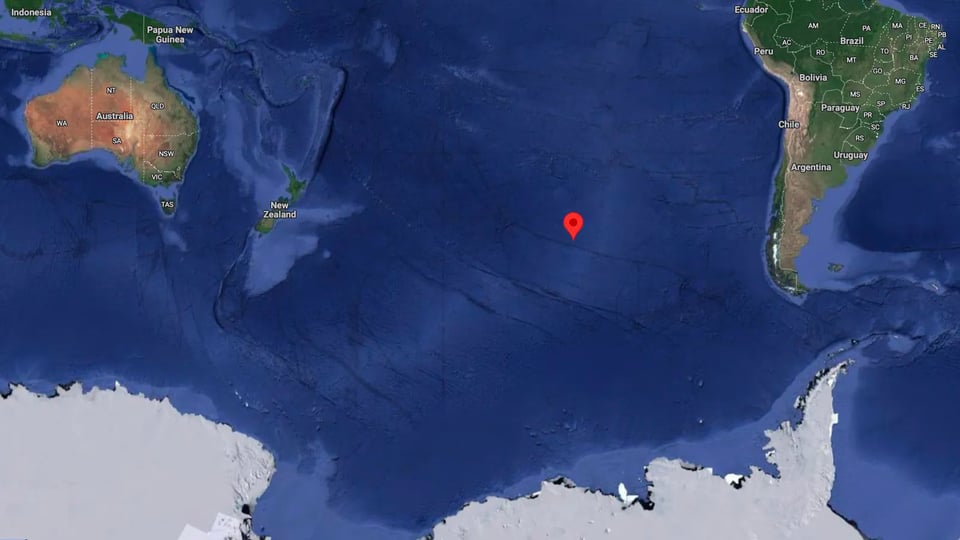
"Point Nemo" is a spot so far out in the Pacific ocean that virtually no human traffic goes anywhere near. That has made it the most popular spot on the planet for countries to crash their decommissioned space missions ...
Between 1971 and 2018, global space powers, including the United States, Russia, Japan and Europe, crashed more than 263 space objects in the uninhabited region of the ocean around Point Nemo. The list includes the Soviet-era Mir space station and six craft from the country's Salyut programme, as well as 140 Russian resupply vehicles, six cargo transfer vehicles launched by Japan, and five from the European Space Agency (Esa). More recently, this oceanic dump is thought to have received part of a SpaceX capsule rocket. And coincidentally, its closest neighbour, the ISS, is expected to splash-land at this remote spot in just eight years.
In that BBC story, scientists speculate that many quite-large chunks of spacecraft -- including a lot of the Soviet space station Mir -- may have survived atmospheric re-entry, so Point Nemo could contain a ton of relics:
All this means that Point Nemo is now – and will likely remain – a goldmine for future archaeologists. "You would study them [spacecraft graveyards] kind of the same way that you would something like a rubbish midden, or a shell midden or something like that," says Gorman. These accumulations of waste thrown away by humans hundreds or thousands of years ago are often exploited by archaeologists to learn about how people lived, including what they ate and what they valued – in the past.
6) 🌪 How the telegraph created weather forecasts

Before the telegraph emerged in the 1830s, it didn't seem possible to forecast weather. Nobody could spy a pattern in whether the sky would be rainy or sunny a few days from now. Weather seemed to be, more or less, random.
The telegraph changed that. People in adjacent cities began trading daily descriptions of their local weather. Then they started noticing connections: It was rainy in the town east of you, the wind was blowing eastwards, then whaddya know -- it was rainy in your town the day after.
So the telegraph basically created the idea of weather prediction.
There's a great story on the web site of the National Endowment for the Humanities that describes how it all went down. The Smithsonian played a big role; it encouraged telegraph operators nationwide to pause briefly each morning and send in descriptions of their local weather.
Pretty soon newspapers were using that info to create their own crude guesswork predictions:
On May 7, 1857, the Washington Evening Star used the Smithsonian’s data to print what is considered to be the first weather forecast in the United States—although contemporary readers might have trouble recognizing it as one. (“Yesterday, there was a severe storm south of Macon, Ga;” the report read before going on to hedge its bets: “But from the fact that it is still clear this morning at that place and at Wheeling, it is probable that the storm was of local character.”)
7) 📈 1849 dataviz of world's mountains and rivers

Behold some amazing dataviz from 1849 -- the first edition of Alexander von Humboldt's "Mountains and Rivers of the World".
He hand-drew each geologic formation, lining them up next to one another so we could see their size. The detail is quite astonishing: Check out these riverheads ...
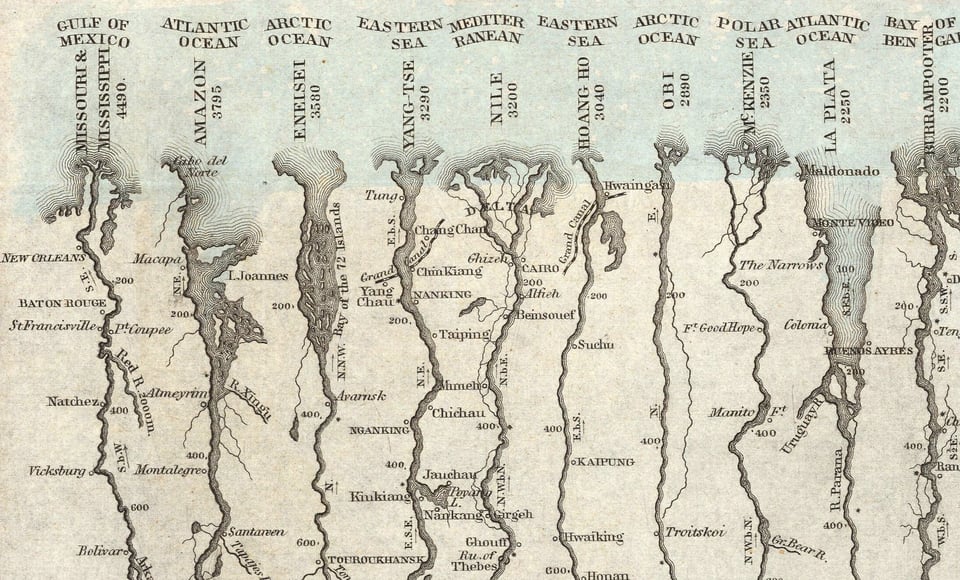
Nick Routley has a bit more info about it on his site, as well as a massive 19-meg scan of the map, so you can do a close-up zoom-in on your computer.
(Thanks to Karl Mitchell for this one!)
8) 🚲 How to cheat in virtual bike-racing

Cheating in sports is eternal, so it probably shouldn't be surprising that we've seen so much of it in esports. I remember back in the late 90s, when Quake tournaments were starting to bring in real dough for winners, and I learned about the Quake cheats -- like code for auto-targeting, or rendering the game in wireframe so you could see through walls.
It turns out now that there's cheating in ... virtual bike-racing!
Over at The Hustle, Katherine Laidlaw has a fascinating piece about Luciano Pollastri, a cyclist who raced on the Zwift platform. On Zwift, you connect your stationary bike to their network and it calculates your "power recording" by dividing your wattage output by your self-reported weight. There are competitive racing teams on Zwift; Pollastri joined one.
But he kept on getting beaten by people in ways that didn't seem explicable. When he investigated, he realized those folks were cheating -- using the most hilariously simple hack.
The riders, he discovered, were ...
... toggling their weight mid-race to falsely inflate their speed and power recording, and cover the race course faster.
Live on camera, he discovered that the cheat worked.
When he posted about, riders around the world emailed to describe over 50 other cheats they'd used, which include:
Zwifters sent videos of themselves not pedaling but still producing high levels of watts.
Some used hair dryers on their sensors to register more power, or paint rollers to exert more pressure on their flywheels.
Elite riders learned the serial codes of batches of smart trainers that overreported a rider’s power, and sought them out on the used market. Anything to add 10 or 20 watts to their overall power.
Never bet against the human propensity to cheat in high-stakes situations.
9) 😈 Why villains in movies don't use Iphones

The director Rian Johnson let slip a fascinating Hollywood secret: If you're watching a movie and wondering who is the hidden villain, it can't be someone who uses an Apple product.
Why? Because Apple won't let you, as part of their marketing and licensing agreements.
“Apple, they let you use iPhones in movies, but – and this is very pivotal – if you’re ever watching a mystery movie, bad guys cannot have iPhones on camera,” Johnson, whose credits include Star Wars: The Last Jedi**,** Looper and Knives Out, revealed in a video recorded for Vanity Fair.
Johnson let the secret slip as he took viewers through an anatomy of a scene in Knives Out, a whodunnit with an ensemble cast including Daniel Craig, Toni Collette and Jamie Lee Curtis.
In the pivotal scene, the will reading following the murder of a rich novelist played by Christopher Plummer, Lee Curtis’s character, Linda Drysdale, is seen holding an iPhone – prompting Johnson to give away the industry secret.
“Every single film-maker who has a bad guy in their movie that’s supposed to be a secret wants to murder me right now,” Johnson added.
BTW, I got this item from Matthew Ingram's terrific newsletter "When The Going Gets Weird", in which he sends out amazing links of stuff to read. A few items in the final section of this "Linkfest" came from his newsletter too! Really worth subscribing.
10) 🚙 Kit for converting a gasoline car into a hybrid
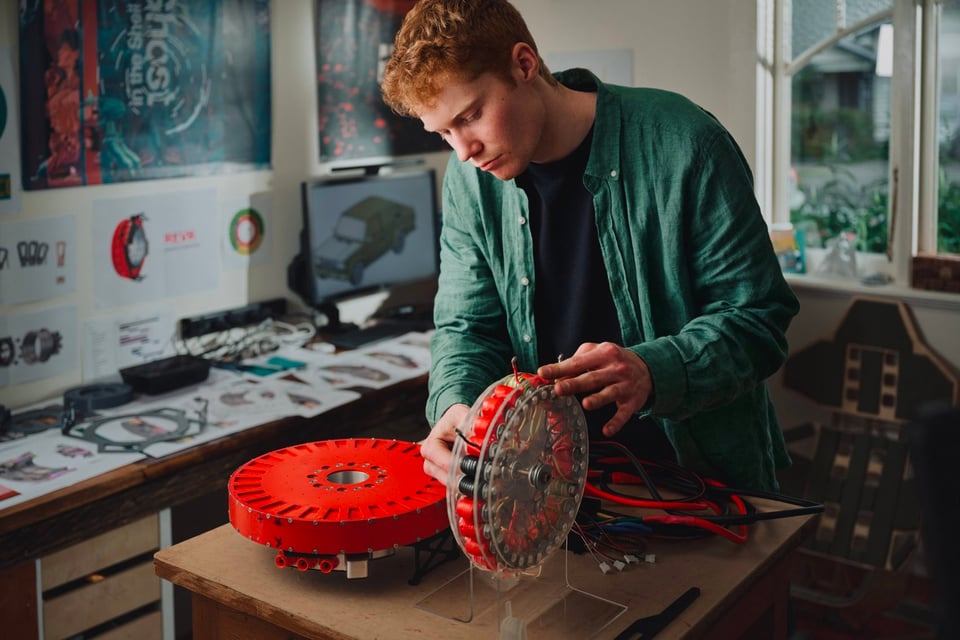
The Australian design student Alexander Burton has made a fascinating prototype -- technology for converting a regular gasoline car into a hybrid.
Basically, he's invented an axial flux motor that he mounts on between the disc brakes and the rear wheels. The batteries go in the wheel-well area; with some software to monitor the relationship with the gas engine, presto: It becomes a hybrid car. As he tells Dezeen ...
"You can't fit a huge battery in a wheel well but we wager you won't need one," said Burton. "While people drive a lot, especially here in Australia, on average they drive 35 kilometres a day and it's mostly commuting."
"This distance would require only a five-kilowatt-hour battery, and we can put three times that in the wheel well."
I'm intrigued! I can see problems with this design, of course. I can't imagine the wheel well is a great location for batteries; it feels too exposed. Maybe giving up some trunk space would work better?
But the general idea of transforming gasoline cars into hybrids? That's really smart. It'd be a superb way to more rapidly electrify the world's existing fleet of fossil-fuel cars. There are an estimated 250 million gas cars in the US alone; they're going to be in use for years and years, so transforming them to have partially-electric drives would be an epic win.
What's more, modifying an existing car to become electric/hybrid confers double benefits, because it avoids the CO2 cost of producing a new hybrid. I mean, I really want us to move towards a world where all cars are EV or hybrids! But manufacturing tons of new hybrids or EVs using existing processes would emit a lot of greenhouse gases, because aluminum-production is still fossil-fuel-intensive. So it's really smart instead to simply convert as many already-existing vehicles as possible.
I'd love to read more about other conversion schemes ...
11) 🌀 Next-gen spirograph

Over on Kickstarter, G.O. Metric is raising money to produce the "Planarc 2.0". It's sort of a next-generation Spirograph, with slightly more complex mechanisms for making even more convoluted patterns than were possible with an old-school Spirograph.
They pitch it as a tool for chillaxing ...
As colors intertwine and designs take shape, users often lose track of time, engrossed in the joy of creating harmonious patterns. The repetitive nature of Spirograph drawing acts as a mindful exercise, encouraging mindfulness and fostering self-awareness.
12) 👾 A final, sudden-death round of reading material
Tyromancy. 👾 Wearable GPS device uses puffs of air to guide you. 👾 Vlad the Impaler may have been vegan. 👾 An island in North Carolina where they speak Elizabethan English. 👾 A digital version of the 17th-century algorithmic music-generator, the "Arca musarithmica". 👾 Christopher Columbus, tech bro. 👾 "Vocational awe." 👾 The mysterious floating circular island of Argentina. 👾 Japanese luggage-forwarding techniques. 👾 Framework laptop guts turned into a cyberdeck. 👾 Fractal music. 👾 Electoral graffiti found inside an ancient house of Pompeii. 👾 The man who runs marathons backwards. 👾 Code samples from the 50s-era Whirlwind computer. 👾 "Rain gardens." 👾 I'm still retrospectively fond of the famous Juicero teardown. 👾 The cabin that inspired "Home on the Range." 👾 Chat with any PDF. 👾 Live lobsters, tattoo guns, and "pet fish in water": A list of surprising things you're allowed to take on US flights. 👾 When the CIA employed vampires. 👾 The metals of Star Wars, and their properties. 👾 Coding vs. woodworking. 👾 The masked "boot girls" of Atlanta. 👾 Apparently cat purring is roughly like "vocal fry". 👾 A shredder that pulls itself forward by eating paper. 👾 The lava lamp shortage. 👾 The difference between "artists" and "craftsman" in science writing. 👾 App for finding your followers' followers on Mastodon. 👾 "Birth striking". 👾 Nature quickly reclaims abandoned mines. 👾 Fighting badgers with Tensorflow. 👾 The 1860 "Dictionary of Modern Slang, Cant, and Vulgar Words". 👾 Offroading solar car drives across Morocco. 👾 Why doctors and surgeons still use pagers. 👾 On the phase-locking of fireflies. 👾 Click on a map location at Maps.fm and it'll play a podcast about that location. 👾 "Hard clicking" 3D-printable fidget spinner. 👾 Sperm appear to break Newton's third law of motion. 👾 Doing your expenses in VR. 👾 Tiny quadruped robot with combustion-actuator legs. 👾 An 800-page novel that consists of a single sentence.